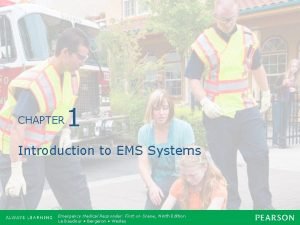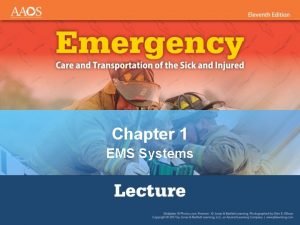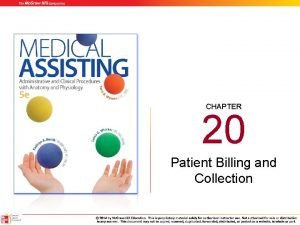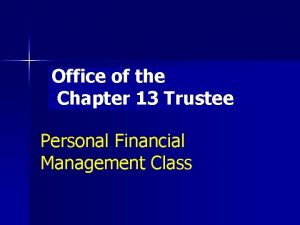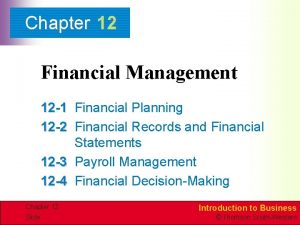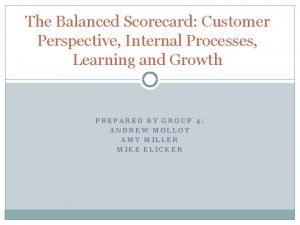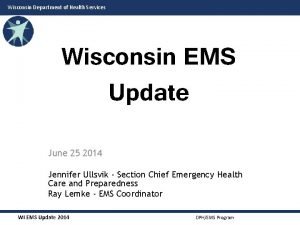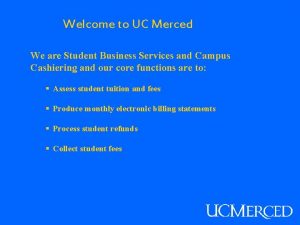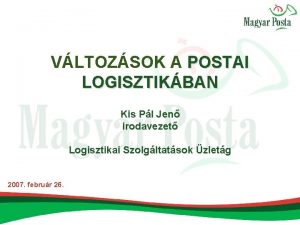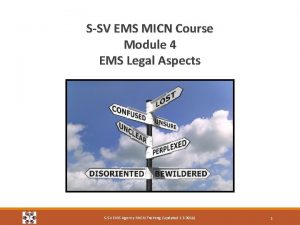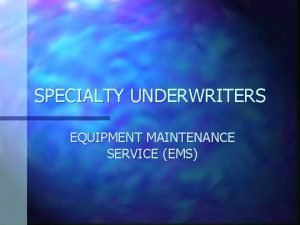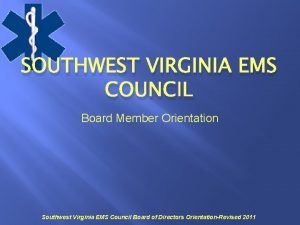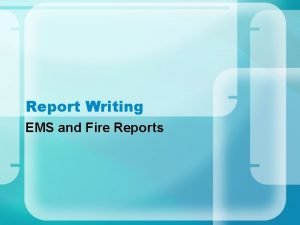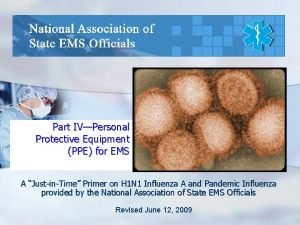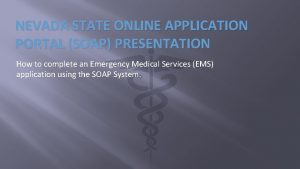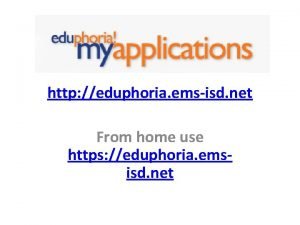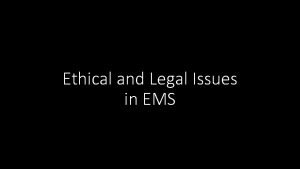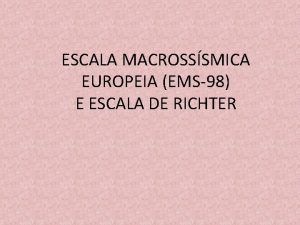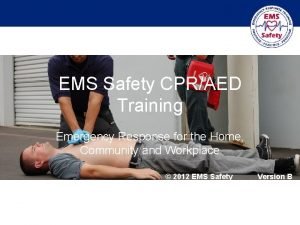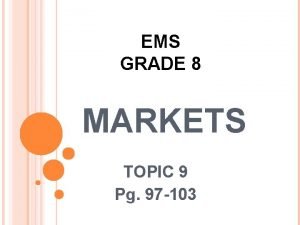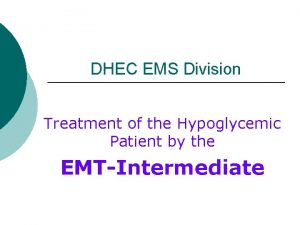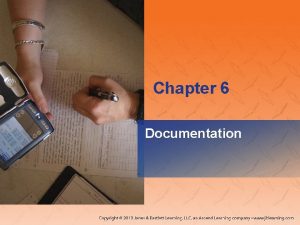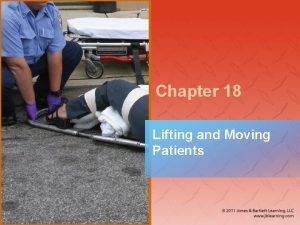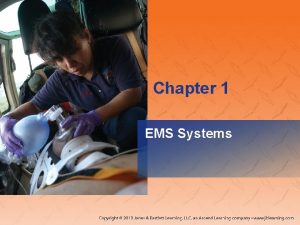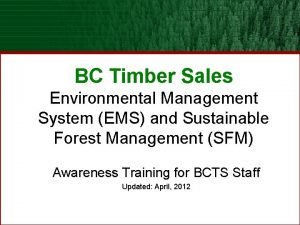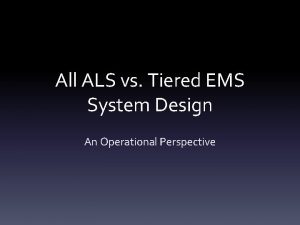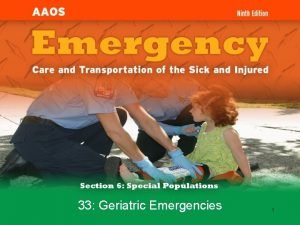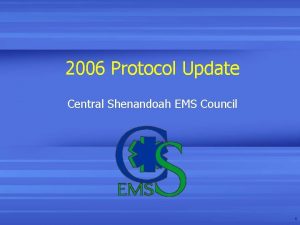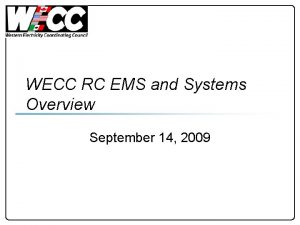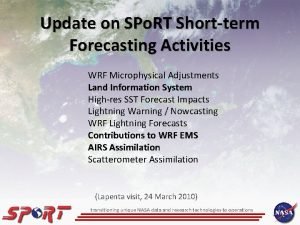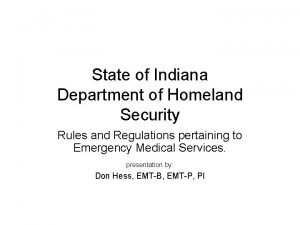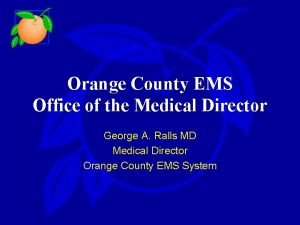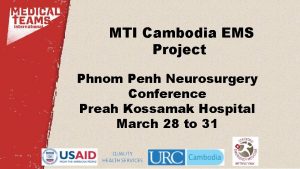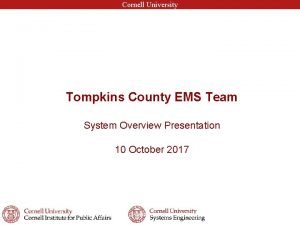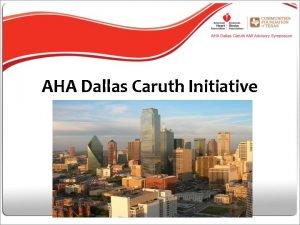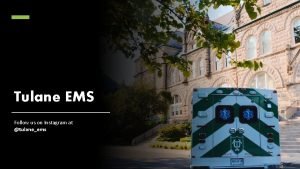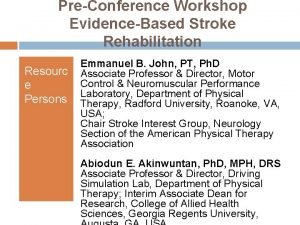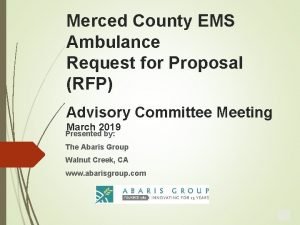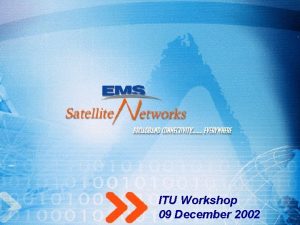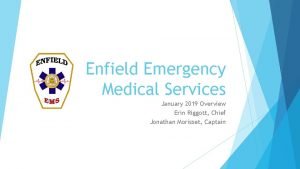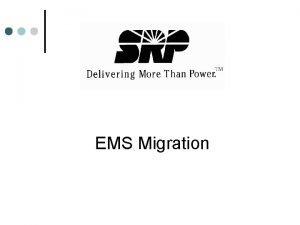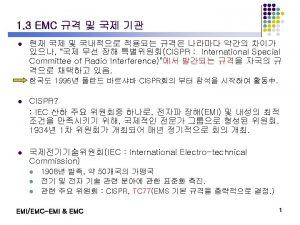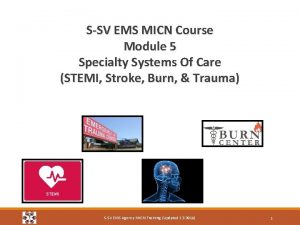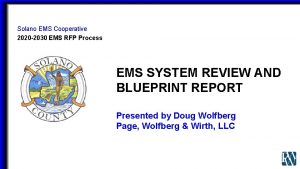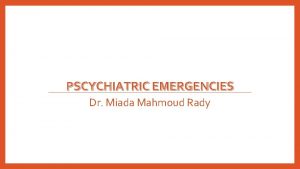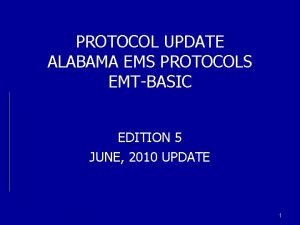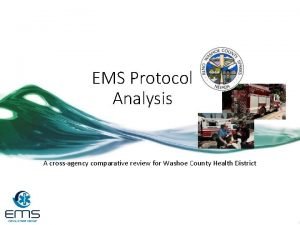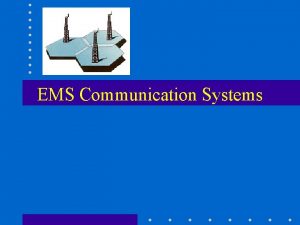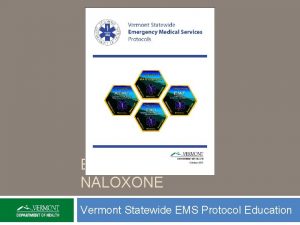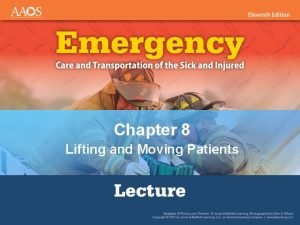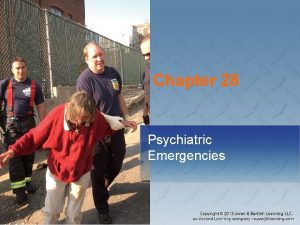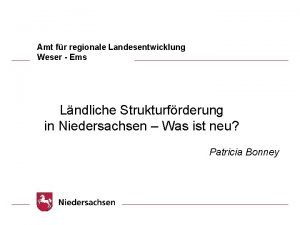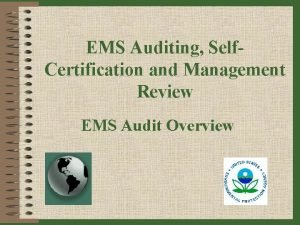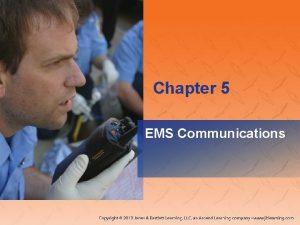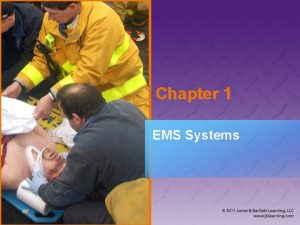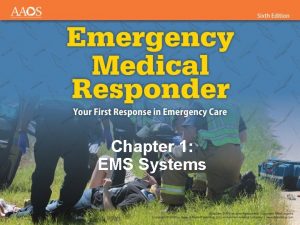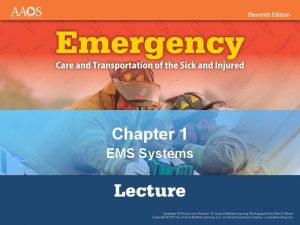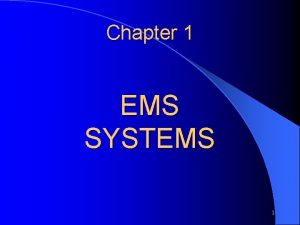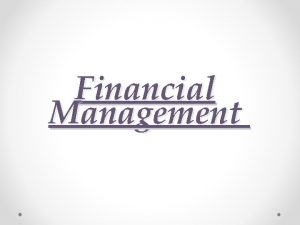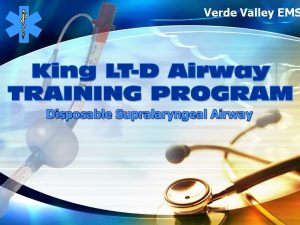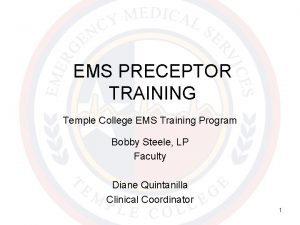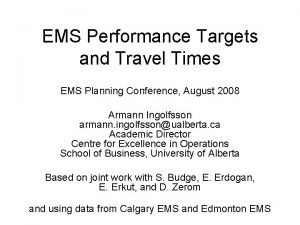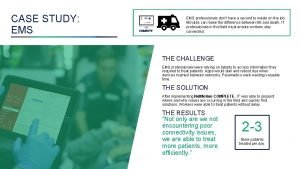Management of EMS 9 CHAPTER Financial Management Learning







































































- Slides: 71

Management of EMS 9 CHAPTER Financial Management

Learning Objectives 9. 1 Discuss the Medicare Ambulance Fee Schedule Final Rule and identify strategies for optimizing reimbursement within its requirements and limitations. 9. 2 Describe the historical development of and programs administered by the Centers for Medicare and Medicaid Services. Bruce E. Evans • Jeff T. Dyar — Management of EMS Copyright © 2010 by Pearson Education, Inc. Upper Saddle River, NJ 07458

Learning Objectives (Cont. ) 9. 3 Identify the requirements of Medicare Part B as they apply to ambulance suppliers, including levels of service, medical necessity, physician certification, origins and destinations, vehicles and staffing. Bruce E. Evans • Jeff T. Dyar — Management of EMS Copyright © 2010 by Pearson Education, Inc. Upper Saddle River, NJ 07458

Learning Objectives (Cont. ) 9. 4 Explain the alternative components used to fund ambulance service. 9. 5 Describe the financial policies that are addressed in budgeting and in types of budgets. 9. 6 Calculate the unit hour utilization and various benchmarks and seasonal fluctuations for various levels of service. Bruce E. Evans • Jeff T. Dyar — Management of EMS Copyright © 2010 by Pearson Education, Inc. Upper Saddle River, NJ 07458

Learning Objectives (Cont. ) 9. 7 Discuss various methods for costing out service. 9. 8 Understand managed-care contracting strategies. Bruce E. Evans • Jeff T. Dyar — Management of EMS Copyright © 2010 by Pearson Education, Inc. Upper Saddle River, NJ 07458

Financial Requirements and Billing • Revenue recovery is important • Ambulance rates and billing should be balanced – Cost of delivering EMS, collection of revenues, and non-service related monies coming into the organization • Rarely will rates reflect the cost of providing services Bruce E. Evans • Jeff T. Dyar — Management of EMS Copyright © 2010 by Pearson Education, Inc. Upper Saddle River, NJ 07458

Who Sets the Rates? • Individual agencies, states, and local jurisdictions set ambulance rates • Medicare and large insurance carriers (third-party payers) set reimbursement rates Bruce E. Evans • Jeff T. Dyar — Management of EMS Copyright © 2010 by Pearson Education, Inc. Upper Saddle River, NJ 07458

Marginal Costing • What is the marginal cost of the ambulance transport? – The cost of providing the transport divided by the transport volume = marginal cost per transport • Revenues collected – Can provide additional monies to enhance other EMS services – All revenues are needed for the delivery of the services Bruce E. Evans • Jeff T. Dyar — Management of EMS Copyright © 2010 by Pearson Education, Inc. Upper Saddle River, NJ 07458

Funding Sources • Many sources of funding: – Public funds § Tax revenues • Sales taxes, property taxes, or impact fees § EMS operating levies § Municipal bonds Bruce E. Evans • Jeff T. Dyar — Management of EMS Copyright © 2010 by Pearson Education, Inc. Upper Saddle River, NJ 07458

Funding Sources (Cont. ) • Many sources of funding: – Government reimbursements § Medicaid § Medicare § Military or government dependent care – Other § Grants, capitated agreements with HMOs, philanthropic donations, and civic group donations and subscription programs Bruce E. Evans • Jeff T. Dyar — Management of EMS Copyright © 2010 by Pearson Education, Inc. Upper Saddle River, NJ 07458

Medicare • Established in 1965 by the Social Security Act – Covered only those older than age 65 from 1965 to 1972 – In 1972 expanded to cover those with disabilities – Transferred to Health Care Financing Administration in 1997 § In 2001 restructured Centers for Medicare and Medicaid Services Bruce E. Evans • Jeff T. Dyar — Management of EMS Copyright © 2010 by Pearson Education, Inc. Upper Saddle River, NJ 07458

Medicare (Cont. ) • Provides coverage for low-income families; aged, blind, and disabled; and those eligible for federally assisted income Bruce E. Evans • Jeff T. Dyar — Management of EMS Copyright © 2010 by Pearson Education, Inc. Upper Saddle River, NJ 07458

SCHIP • State Children’s Health Insurance Program – Established in 1997, as part of the Balanced Budget Act – Allowed states to provide health insurance for children Bruce E. Evans • Jeff T. Dyar — Management of EMS Copyright © 2010 by Pearson Education, Inc. Upper Saddle River, NJ 07458

Balanced Budget Act of 1997 • Reformulated the ambulance fee structure through negotiated rulemaking conducted by: – Industry stakeholders who negotiate the regulations specifying how ambulance services are reimbursed under Medicare Bruce E. Evans • Jeff T. Dyar — Management of EMS Copyright © 2010 by Pearson Education, Inc. Upper Saddle River, NJ 07458

Organizations Represented on the Negotiated Rulemaking Committee FIGURE 9. 1 Organizations Represented on the Negotiated Rulemaking Committee. Bruce E. Evans • Jeff T. Dyar — Management of EMS Copyright © 2010 by Pearson Education, Inc. Upper Saddle River, NJ 07458

Medicare Part B • EMS systems are classified according to the level of service provided • ICD-9 coding – Not required on most ambulance claims – Does not generally trigger a payment or a denial of a claim Bruce E. Evans • Jeff T. Dyar — Management of EMS Copyright © 2010 by Pearson Education, Inc. Upper Saddle River, NJ 07458

Medicare Part B (Cont. ) • ICD-9 coding – Each patient receives a primary and alternative code – Primary code § Reflects condition on scene – Secondary code § Reflect on scene changes from the dispatch information versus what was found on scene Bruce E. Evans • Jeff T. Dyar — Management of EMS Copyright © 2010 by Pearson Education, Inc. Upper Saddle River, NJ 07458

Levels of EMS Service • • Basic Life Support (BLS) Advanced Life Support 1 (ALS 1) Advanced Life Support 2 (ALS 2) Specialty Care Transport (SCT) Units Paramedic Intercept (PI) Fixed Wing (FW) Rotary Wing (RW) Bruce E. Evans • Jeff T. Dyar — Management of EMS Copyright © 2010 by Pearson Education, Inc. Upper Saddle River, NJ 07458

Basic Life Support • If the state allows EMT Basics to initiate IV lines or administer medications, regulations mandate reimbursement at the basic life support level Bruce E. Evans • Jeff T. Dyar — Management of EMS Copyright © 2010 by Pearson Education, Inc. Upper Saddle River, NJ 07458

Medically Necessary • Medicare only allows billing at the ALS level when medical necessity has been met – ALS assessment is provided – Information at time of dispatch meets ALS level Bruce E. Evans • Jeff T. Dyar — Management of EMS Copyright © 2010 by Pearson Education, Inc. Upper Saddle River, NJ 07458

Upbilling • A misrepresentation of provided services by billing for more expensive service – For example, if an agency performs an ALS assessment on every patient in an attempt to gain ALS reimbursement • Can result in fines, criminal charges, or suspension of Medicare benefits Bruce E. Evans • Jeff T. Dyar — Management of EMS Copyright © 2010 by Pearson Education, Inc. Upper Saddle River, NJ 07458

Advanced Life Support, (Level 1) • At least one ALS intervention is performed – “Medically necessary” ALS assessment § An assessment that requires the use of ALS evaluation tools (such as ECG) Bruce E. Evans • Jeff T. Dyar — Management of EMS Copyright © 2010 by Pearson Education, Inc. Upper Saddle River, NJ 07458

Advanced Life Support, (Level 2) • Must include the administration of at least three intravenous medications or the performance of at least one of the following skills: – Manual defibrillation/cardioversion, endotracheal intubation, central venous line placement, cardiac pacing, chest decompression, a surgical airway, an intraosseous line Bruce E. Evans • Jeff T. Dyar — Management of EMS Copyright © 2010 by Pearson Education, Inc. Upper Saddle River, NJ 07458

Specialty Care Transport • Inter-facility transports requiring level beyond the scope of paramedic care • A higher level of billing • May be billed under Medicare Part A, but: – Must have a physician-documented medical reason for the trip Bruce E. Evans • Jeff T. Dyar — Management of EMS Copyright © 2010 by Pearson Education, Inc. Upper Saddle River, NJ 07458

Paramedic Intercept • Paramedic services provided by nontransporting entity • Limitations: – Billing agency must bill all recipients of service regardless of Medicare status – Area must be a rural service area – Must be certified as an ALS service Bruce E. Evans • Jeff T. Dyar — Management of EMS Copyright © 2010 by Pearson Education, Inc. Upper Saddle River, NJ 07458

Fixed Wing and Rotary Wing • Fixed and rotary wing aircraft – Covered when point of pickup is inaccessible by a land vehicle, great distances are involved, or other obstacles that are not defined by the rule-making committee Bruce E. Evans • Jeff T. Dyar — Management of EMS Copyright © 2010 by Pearson Education, Inc. Upper Saddle River, NJ 07458

Calculation of Ambulance Fees • Base rate adjusted for geographical cost differences • Geographic physician cost index (GPCI) • National base rate of $204. 65 • Take 70% and apply the GPCI – The remaining 30% of the $204. 65 is added to the adjusted figure Bruce E. Evans • Jeff T. Dyar — Management of EMS Copyright © 2010 by Pearson Education, Inc. Upper Saddle River, NJ 07458

Mileage • Services can charge for a loaded mileage, which starts at point of pick up • Currently rate of $5. 47 per loaded mile but goes up annually • Zip code must be documented on each claim • Loaded miles only Bruce E. Evans • Jeff T. Dyar — Management of EMS Copyright © 2010 by Pearson Education, Inc. Upper Saddle River, NJ 07458

Medicare Rates • Rates increase based on the CPI-urban percentage increase • Nonemergency transports require a physician certification statement (PCS) to bill Medicare – Signed by a physician; if not available, then a nurse, physician assistant, or nurse practitioner may sign Bruce E. Evans • Jeff T. Dyar — Management of EMS Copyright © 2010 by Pearson Education, Inc. Upper Saddle River, NJ 07458

Billing for Multiple Patients • Medicare will reimburse multiple patients in the following manner: – Two patients § Will reimburse 75% of base rate for each patient – Three or more patients § Will reimburse 60% of base rate for each patient Bruce E. Evans • Jeff T. Dyar — Management of EMS Copyright © 2010 by Pearson Education, Inc. Upper Saddle River, NJ 07458

Reimbursement Involving Death • If death is pronounced before the ambulance is called, then no reimbursement will be made • If death is pronounced after transport has begun, then normal nonemergency rates apply but no mileage and before arrival on scene • If death is pronounced during transport, normal reimbursement rates apply Bruce E. Evans • Jeff T. Dyar — Management of EMS Copyright © 2010 by Pearson Education, Inc. Upper Saddle River, NJ 07458

Causes of Claim Denial FIGURE 9. 3 Causes of Claim Denial. Bruce E. Evans • Jeff T. Dyar — Management of EMS Copyright © 2010 by Pearson Education, Inc. Upper Saddle River, NJ 07458

Scheduled Transfers • Medically necessary = success in billing • Medical necessity is established when the patient’s condition is such that transfer by any other means of transportation would endanger the health of the patient Bruce E. Evans • Jeff T. Dyar — Management of EMS Copyright © 2010 by Pearson Education, Inc. Upper Saddle River, NJ 07458

Scheduled Transfers (Cont. ) • Actual reason for the transfer by ambulance and exactly why the patient cannot ride in a car is required on run report Bruce E. Evans • Jeff T. Dyar — Management of EMS Copyright © 2010 by Pearson Education, Inc. Upper Saddle River, NJ 07458

Future Medicare Changes • Medicare will become stricter • Expect to see: – Performance-based reimbursement § Will force EMS providers to provide care and complete transport based on medical necessity and evidence-based medicine – Evidence-based medicine § Interventions and actions that produce a positive outcome for the patient Bruce E. Evans • Jeff T. Dyar — Management of EMS Copyright © 2010 by Pearson Education, Inc. Upper Saddle River, NJ 07458

Future Medicare Changes (Cont. ) • Medicare Payment Advisory Committee – “Medpac” – May decide not to pay for the cost of the EMS to work an arrest knowing that evidence-based medicine indicates this will not have a favorable or positive outcome § Expect the same trend from third-party private insurance companies Bruce E. Evans • Jeff T. Dyar — Management of EMS Copyright © 2010 by Pearson Education, Inc. Upper Saddle River, NJ 07458

Third-Party Billing • Anyone other than Medicare, Medicaid, or self-paying patient • Private insurance companies – HMOs, workers’ compensation insurance • Commercial automobile insurance • Homeowner insurance Bruce E. Evans • Jeff T. Dyar — Management of EMS Copyright © 2010 by Pearson Education, Inc. Upper Saddle River, NJ 07458

Third-Party Billing (Cont. ) • Restitution from crime victims • Bankruptcy, probate, small claims • Service organizations, travel insurance, embassies Bruce E. Evans • Jeff T. Dyar — Management of EMS Copyright © 2010 by Pearson Education, Inc. Upper Saddle River, NJ 07458

HMO Contracting • Negotiated fees for service should actually represent costs • Can limit payment delays with good contract language • Definitions should be clear • Establish prompt payment rules and enforce them • Payment options Bruce E. Evans • Jeff T. Dyar — Management of EMS Copyright © 2010 by Pearson Education, Inc. Upper Saddle River, NJ 07458

HMO Contracting (Cont. ) • Capitated contract – Annual lump sum payment to the provider to cover an estimated number of patients under their plan – If EMS can provide service at a cost less than what it is paid, the agency can generate a surplus – If costs rise above capitated amount, the agency experiences a loss • Disease management coordinators Bruce E. Evans • Jeff T. Dyar — Management of EMS Copyright © 2010 by Pearson Education, Inc. Upper Saddle River, NJ 07458

Financial Policy • Budgets – Basic, ongoing, or continuous expenses should be calculated § Equipment and supplied, vehicles and fuel, medical supplies, facilities, communications, personnel, training, and licensing – Indirect cost § Resources used that are necessary for logistics or infrastructure Bruce E. Evans • Jeff T. Dyar — Management of EMS Copyright © 2010 by Pearson Education, Inc. Upper Saddle River, NJ 07458

Financial Policy (Cont. ) • Budgets (Cont. ) • Indirect cost § Cannot be traced directly to a specific product or service provided by the EMS agency • Insurance, legal and consultation, medical directors, billing services, contract service – Variable cost § Changes in total proportion to changes in the related level of total activity or volume – Fixed costs § Remain unchanged in total for a given period of time Bruce E. Evans • Jeff T. Dyar — Management of EMS Copyright © 2010 by Pearson Education, Inc. Upper Saddle River, NJ 07458

EMS Budgets • Line-item budget – Focuses on inputs – Specific items or services by division, department, and unit – Easy to balance – Often requires last-minute spending to empty accounts – Does not focus on results Bruce E. Evans • Jeff T. Dyar — Management of EMS Copyright © 2010 by Pearson Education, Inc. Upper Saddle River, NJ 07458

EMS Budgets (Cont. ) • Integrative budgeting system – Modification of line-item budget – Three computerized categories: § Personnel, operations, and capital outlays Bruce E. Evans • Jeff T. Dyar — Management of EMS Copyright © 2010 by Pearson Education, Inc. Upper Saddle River, NJ 07458

EMS Budgets (Cont. ) • Service-based budget – Focuses on outputs or specific services, not dollars – All aspects of a specific type of service – Calls processes “call centers” – Requires full costing or recording of both the direct and indirect costs Bruce E. Evans • Jeff T. Dyar — Management of EMS Copyright © 2010 by Pearson Education, Inc. Upper Saddle River, NJ 07458

EMS Budgets (Cont. ) • Activity-based cost system – Assigns costs to activities – Cost objects are based on the consumption of resources • Attribute-based cost system – Integrates cost with quality, function, and deployment – Provides means for examining performance in the EMS system and customer levels Bruce E. Evans • Jeff T. Dyar — Management of EMS Copyright © 2010 by Pearson Education, Inc. Upper Saddle River, NJ 07458

EMS Budgets (Cont. ) • Program-based budget – All costs are summarized for each program, rather than placed in broad categories – Links system costs with results – Limits most line items for lump sums to major objects in EMS operations Bruce E. Evans • Jeff T. Dyar — Management of EMS Copyright © 2010 by Pearson Education, Inc. Upper Saddle River, NJ 07458

EMS Budgets (Cont. ) • Performance-based budgeting – Develops workload and unit costs – Specified categories are personnel, maintenance, operations, and development – Commonly used for shared functions Bruce E. Evans • Jeff T. Dyar — Management of EMS Copyright © 2010 by Pearson Education, Inc. Upper Saddle River, NJ 07458

EMS Budgets (Cont. ) • Zero-based budgeting – Requires EMS to justify the existence of a budget for the program or item – Takes a significant amount of administrative time – Has lost popularity – Employed only when a city or department is facing budget shortfalls or there is an economic downturn Bruce E. Evans • Jeff T. Dyar — Management of EMS Copyright © 2010 by Pearson Education, Inc. Upper Saddle River, NJ 07458

Cost Per Response • Determined by dividing each provider’s total expenses by the total number of responses • Cost of service must include overhead that is allocated in a one-month period divided by the total responses in the same one-month period Bruce E. Evans • Jeff T. Dyar — Management of EMS Copyright © 2010 by Pearson Education, Inc. Upper Saddle River, NJ 07458

Cost Per Response • Used primarily for purposes of comparison to other service delivery models in EMS Bruce E. Evans • Jeff T. Dyar — Management of EMS Copyright © 2010 by Pearson Education, Inc. Upper Saddle River, NJ 07458

Calculating Unit Hours • Total cost per unit is a measure of the total cost of providing coverage during a given accounting period divided by the total number of unit hours of coverage during the same accounting period • Can be used to identify whether or not unit-hour costs are excessive given the quality of care being delivered Bruce E. Evans • Jeff T. Dyar — Management of EMS Copyright © 2010 by Pearson Education, Inc. Upper Saddle River, NJ 07458

Calculating Unit Hours (Cont. ) • Top-heavy administration, high wages, poor economies of scale, overtime pay can drive up unit-hour cost • When you have excessive unit-hour costs with poor response times, consideration should be given to moving vehicles or adding units • Vehicle operating costs Bruce E. Evans • Jeff T. Dyar — Management of EMS Copyright © 2010 by Pearson Education, Inc. Upper Saddle River, NJ 07458

Cost-Per-Unit Hour FIGURE 9. 7 Cost-Per-Unit Hour. Bruce E. Evans • Jeff T. Dyar — Management of EMS Copyright © 2010 by Pearson Education, Inc. Upper Saddle River, NJ 07458

Calculating Unit-Hour Utilization • Queuing theory – Study of waiting lines and the consequences of these lines – Excellent method for determining how many EMS units are needed to handle calls – Can estimate how busy EMS units are, probability of a call, waiting time, number of units needed to satisfy operations Bruce E. Evans • Jeff T. Dyar — Management of EMS Copyright © 2010 by Pearson Education, Inc. Upper Saddle River, NJ 07458

Unit Hour Utilization • Measurement of workload for EMS agencies • Developed from queuing theory • Used to determine the line between too few ambulances and putting an ambulance on every corner • Must know the number of EMS calls and amount of time a crew spends on an ambulance call • U: UH ratio Bruce E. Evans • Jeff T. Dyar — Management of EMS Copyright © 2010 by Pearson Education, Inc. Upper Saddle River, NJ 07458

Benchmarks of Unit-Hour Utilization • Can be challenged as a measurement tool applicable only to private industry • Three additional measurements are made in some high performance or heavy workload systems: – Unit-hour utilization-transport – Unit-hour utilization-responses – Unit-hour utilization-total deployment • Seasonal variations Bruce E. Evans • Jeff T. Dyar — Management of EMS Copyright © 2010 by Pearson Education, Inc. Upper Saddle River, NJ 07458

Managing Unit Hours • How many EMS units does a system need? • Formula – Calls per hour X average time for each call divided by 60 minutes X unit-hour utilization Bruce E. Evans • Jeff T. Dyar — Management of EMS Copyright © 2010 by Pearson Education, Inc. Upper Saddle River, NJ 07458

FIGURE 9. 16 Marginal Personnel Worksheet. (Source: International Association of Firefighters EMS Implementation Guidebook. Reprinted with permission. ) Bruce E. Evans • Jeff T. Dyar — Management of EMS Copyright © 2010 by Pearson Education, Inc. Upper Saddle River, NJ 07458

FIGURE 9. 17 Wage Calculation Worksheet. (Source: International Association of Firefighters EMS Implementation Guidebook. Reprinted with permission. ) Bruce E. Evans • Jeff T. Dyar — Management of EMS Copyright © 2010 by Pearson Education, Inc. Upper Saddle River, NJ 07458

Subsidy-Price Trade-Off • Collect all the estimated and total payments for all emergency and nonemergency services from all sources – Includes HMO contracts, Medicare, Medicaid • Number is then divided by the population of the primary service area and plotted on the horizontal axis of subsidy price trade-off chart Bruce E. Evans • Jeff T. Dyar — Management of EMS Copyright © 2010 by Pearson Education, Inc. Upper Saddle River, NJ 07458

Subsidy-Price Trade-Off (Cont. ) • Second point on the chart is calculated by estimating the current average total bill, which includes the base rate, mileage, and all add-on charges • The average is then graphed on the vertical axis, and a line is drawn between the two points • The diagonal line can be compared with proposed changes in the service or budget Bruce E. Evans • Jeff T. Dyar — Management of EMS Copyright © 2010 by Pearson Education, Inc. Upper Saddle River, NJ 07458

Funding Mechanisms • Majority of local government budgets are funded by taxes – Property taxes, local income taxes, general sales taxes • Millage rate – Special taxes collected for fire and EMS – Defined as dollars per $1, 000 of assessed value Bruce E. Evans • Jeff T. Dyar — Management of EMS Copyright © 2010 by Pearson Education, Inc. Upper Saddle River, NJ 07458

Funding Mechanisms (Cont. ) • Property taxes – Assessed value is typically 40% of the fair market value of the property • Sales taxes – Sometimes called gross-receipts tax – Tax on the total amount of the sale price of all sales Bruce E. Evans • Jeff T. Dyar — Management of EMS Copyright © 2010 by Pearson Education, Inc. Upper Saddle River, NJ 07458

Funding Mechanisms (Cont. ) • Impact fees – Assessments on new construction, new business, or activities as a one-time fee for infrastructure Bruce E. Evans • Jeff T. Dyar — Management of EMS Copyright © 2010 by Pearson Education, Inc. Upper Saddle River, NJ 07458

Ambulance Membership Programs • A fixed-price pre-payment of all or part of fee-for-service ambulance service bills for a certain period of time • Two types of subscriptions: – In first type, provider may not bill third party payers; all costs are supplied by membership – In second type, provider may bill and collect from third party payers; co-pays are taken care of by membership Bruce E. Evans • Jeff T. Dyar — Management of EMS Copyright © 2010 by Pearson Education, Inc. Upper Saddle River, NJ 07458

Ambulance Membership Programs (Cont. ) • Linked to the goals of the organization • Can provide additional personnel, equipment, enhanced training, a mechanism to improve marketing and customer service • Works best when the public is sensitive to ambulance rates Bruce E. Evans • Jeff T. Dyar — Management of EMS Copyright © 2010 by Pearson Education, Inc. Upper Saddle River, NJ 07458

Billing Service • Billing and collection is often contracted to a vendor or firm with expertise • EMS agencies should develop a list of the services required before looking for billing services • Billing services can provide training and may improve collection rates • Billing contract inclusions Bruce E. Evans • Jeff T. Dyar — Management of EMS Copyright © 2010 by Pearson Education, Inc. Upper Saddle River, NJ 07458

Financial Reports • • Help provide accountability Required by law Identify the health of the organization Components of an EMS financial report: – Total gross billings, collection rates, billing mix, ALS versus BLS, miles billed, transfers versus primary 911 billings, payee mix, accounts receivable turnover rate, bad debt expenses, contractual allowances, writeoffs Bruce E. Evans • Jeff T. Dyar — Management of EMS Copyright © 2010 by Pearson Education, Inc. Upper Saddle River, NJ 07458

Summary • Costs of service must be calculated as accurately and with as much detail as possible • Costs should be tracked for operational decisions • Billing is complex and ever-changing process that requires expert knowledge of regulations and billing techniques Bruce E. Evans • Jeff T. Dyar — Management of EMS Copyright © 2010 by Pearson Education, Inc. Upper Saddle River, NJ 07458

Summary (Cont. ) • Alternative means of funding should continually be explored • Financial reports should be given to the management team and used in strategic planning Bruce E. Evans • Jeff T. Dyar — Management of EMS Copyright © 2010 by Pearson Education, Inc. Upper Saddle River, NJ 07458
 Cuadro comparativo de e-learning
Cuadro comparativo de e-learning Introduction to ems systems chapter 1
Introduction to ems systems chapter 1 Ems systems chapter 1
Ems systems chapter 1 Financial methods of motivation definition
Financial methods of motivation definition Financial management chapter 8 risk and return
Financial management chapter 8 risk and return The process of classifying and reviewing past due accounts
The process of classifying and reviewing past due accounts Chapter 13 personal financial management course
Chapter 13 personal financial management course Chapter 12 money management strategy answers
Chapter 12 money management strategy answers Chapter 16 money management and financial planning
Chapter 16 money management and financial planning Chapter 16 money management and financial planning
Chapter 16 money management and financial planning Chapter 9 financial management
Chapter 9 financial management Fge financial management
Fge financial management Chapter 1 an overview of financial management
Chapter 1 an overview of financial management Chapter 9 financial management
Chapter 9 financial management Balanced scorecard customer perspective
Balanced scorecard customer perspective Wisconsin ems license
Wisconsin ems license Uc merced ems
Uc merced ems Ems felvételre kijelölt posták
Ems felvételre kijelölt posták How to program verdant thermostat
How to program verdant thermostat Ssv ems
Ssv ems Ems equipment repair
Ems equipment repair Southwest va ems council
Southwest va ems council Ems latlit
Ems latlit How to write an ems narrative
How to write an ems narrative Nbitrex
Nbitrex Nevada ems soap
Nevada ems soap Ems iso 9001
Ems iso 9001 Emsisd eduphoria login
Emsisd eduphoria login Ethical issues in ems
Ethical issues in ems Escala macrosísmica europea
Escala macrosísmica europea For adult
For adult Markets ems grade 8
Markets ems grade 8 Hotmail
Hotmail Dhec ems
Dhec ems Soap method ems
Soap method ems Short backboards are usually used to
Short backboards are usually used to National ems standards
National ems standards Bcts ems
Bcts ems Ems system design
Ems system design Gems geriatric diamond
Gems geriatric diamond Business plan grade 9 ems example
Business plan grade 9 ems example Central shenandoah ems council
Central shenandoah ems council Ems cortal
Ems cortal Wrf ems
Wrf ems Indiana department of homeland security ems
Indiana department of homeland security ems ²orange
²orange Ems cambodia
Ems cambodia Identify the progressive discipline system of ems
Identify the progressive discipline system of ems Delta dore ems
Delta dore ems Ems abb
Ems abb Idaho state communications
Idaho state communications Cornell university ems
Cornell university ems Lifeline ems duncanville
Lifeline ems duncanville Tulane ems
Tulane ems Treadmill ems workshop
Treadmill ems workshop Merced county ems
Merced county ems Ems itu
Ems itu Bcts ems
Bcts ems Enfield ems
Enfield ems Ems migration
Ems migration Emi ems
Emi ems Juicer ems assembly
Juicer ems assembly Ssv ems
Ssv ems Ems cooperative
Ems cooperative Mental status coastmap
Mental status coastmap Alabama ems protocols
Alabama ems protocols Ssv ems protocols
Ssv ems protocols Laptop ems workshop
Laptop ems workshop Ems
Ems Rapid extrication technique
Rapid extrication technique Coastmap ems
Coastmap ems Amt für regionale landesentwicklung weser-ems
Amt für regionale landesentwicklung weser-ems

